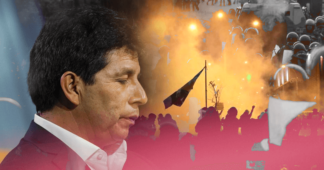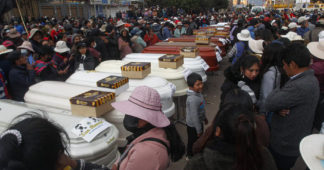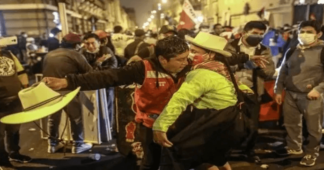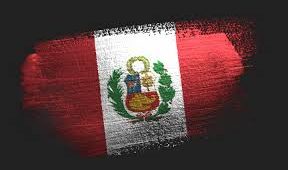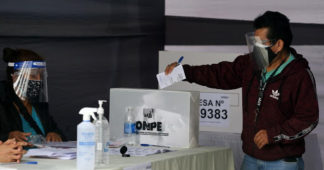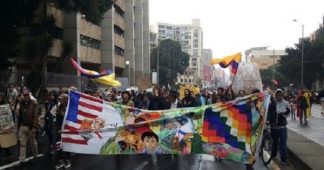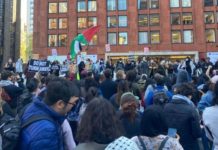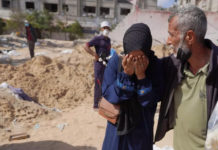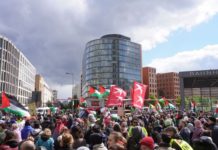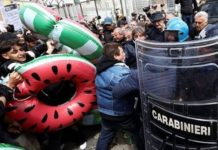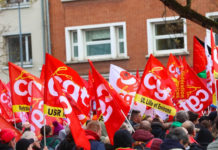Peru is now in its third week of protests, triggered by the impeachment of former president Pedro Castillo. The country’s rural poor are decrying his removal and calling for new elections and a constitutional assembly.
An interview with Anahí Durand
Interview by Nicolas Allen
Jan 9, 2023
Less expected, however, was the outpouring of indignation across Peru in the days and weeks following Castillo’s removal. On one level, nationwide street protests were understandable: the ongoing legitimacy crisis in Peru, responsible, among other things, for bringing an unknown rural schoolteacher to power, has only grown more severe under Castillo’s watch. Right-wing conspiracy and left-wing infighting under his term further stoked popular disenchantment with the Peruvian political class, which already ranked among the most unpopular in the Western Hemisphere. That Castillo’s replacement, the unelected, some would add illegitimate government of Dina Boluarte, intended to serve out the remainder of a five-year term, was a bridge too far.
But the protests in Peru, now in their third week, are also an expression of the aspirations of the nadies, or “nobodies,” who deposited their hopes in the figure of Castillo. Whatever else Castillo may have accomplished as head of state, however little he managed to advance the struggles of his downtrodden electors, he did embody the popular will of a sizable portion of the Peruvian people. For the protesters, the message of Castillo’s impeachment was clear: the demands of the poor, indigenous, peasant, and precarious are not legitimate.
Anahí Durand served as minister of women and vulnerable populations under Castillo’s government, witnessing firsthand the administration’s frustrated attempts to build a base of popular support in the Peruvian hinterland. She spoke to Jacobin commissioning editor Nicolas Allen about the demands of the protest movement and about how, ironically, Castillo’s greatest legacy may have been to politicize those layers of Peruvian society that have taken to the street, often risking their lives.
Nicolas Allen We’re now in the third week of protests in Peru, triggered by Pedro Castillo’s removal from office. Many had predicted that the right-wing majority in Congress would eventually get its way and impeach Castillo; others foresaw that his impeachment would bring social upheaval. But few seemed to anticipate the magnitude and intensity of these protests, which are calling for the closure of Congress and new elections.
Anahí Durand Most of us knew that getting rid of Castillo wasn’t going to be as simple as it was with the last four presidents of Peru [who were impeached as well]. We knew that it would unleash a wave of protests by his supporters and everyday citizens. But the white, Lima-based business elite and the political right never recognized his victory and simply hated Castillo — they didn’t even recognize him as their president and called him “a donkey.” Basically, I think that part of society got lost in its own echo chamber and sincerely believed there would be no repercussions for its actions.
Take, for example, Dina Boluarte, the acting president. She was completely convinced that the Peruvian people would welcome her with open arms after Castillo’s impeachment. She pledged she would serve out a full term, until July 28, 2026, and then took a photo with Castillo’s ousters in Congress, smiling and showing the “V” sign for victory. A few days later protests exploded across the country, with four casualties.
On the other hand, I think the scale of these popular protests caught us all off guard, and not just the Peruvian ruling class. We Peruvians are used to thinking of ourselves as a totally fragmented society where only sectoral protests take place, and usually only for “narrow” economic reasons: the cocaleros over there, the miners in the North over there, the indigenous communities from the Amazon over here.
Instead, what we have is an upheaval that is nationwide. True, the epicenters of the protest are outside Lima and especially concentrated in the Andean south — it was there that the first ten deaths took place, in the heavily Andean region of Apurímac. In the two major cities of that region, Andahuaylas and Abancay, people are marching in huge numbers, seizing airports, highways, and other territories. Meanwhile, the army is firing live ammo on protesters. Three of the protesters killed in the early days of the protests were high schoolers who had walked out of class. Another epicenter in the South is Arequipa, where there have been at least five deaths. Ayacucho has also seen ten or more deaths.
Nicolas Allen Generally speaking, what parts of society are protesting?
Anahí Durand The excluded, marginalized, informal, rural, and indigenous sectors — the same ones that backed the president. The coca farmers, informal mine workers, the community security forces, known as ronderos, and the indigenous communities are out in large numbers in places like Cajamarca, Ayacucho, Arequipa, and Puno, sometimes joined by university students and other groups. The decision to take part in the protests is often made collectively as a community.
The demonstrations are massive and can get violent: airports, highways, and commercial areas have been seized by protesters. After days of that, the government of Dina Boluarte declared a state of emergency and restricted the right to assembly and freedom of movement. Her government did, however, finally give in and bring forward elections to April 24, 2024. But those are not the demands of the people — they want the immediate closure of Congress, immediate general and congressional elections, and a new constitution. Those demands are being completely ignored.
Pedro Castillo ran on the promise of a new constitution in 2021. But since then Congress has done everything in its power to prevent that from happening, relying on unconstitutional means to deny the right to a referendum. Now the people are demanding that right more strongly than ever.

Of course, the people’s third demand is that Castillo be released. Castillo was not only impeached but also arrested in a totally irregular manner and charged with “rebellion” [for calling for the closure of Congress] without ever going through the due legal steps. The point of impeaching him in this manner was to humiliate him and his supporters — they’re trying to make an example of him. There are also those calling for his restitution, although there’s less consensus around that issue.
The protesters are overwhelmingly calling for Boluarte, Castillo’s vice president and current acting president, to step down. They want, at the very least, a custodian government to oversee the transition until elections are held in 2024.
In some regions, the protests are starting to ebb, mostly because of unrelenting military violence. The twenty-eight dead protesters, none of whom were armed or committing any kind of “terrorism,” are simply seen by this government as collateral damage. Right-wing congressman Jorge Montoya openly admitted that removing Castillo would require this kind of bloodshed.
Nicolas Allen Speaking of the military, it’s interesting to note the prominent role of the Peruvian armed forces in recent events: first, Castillo tried in vain to appeal to the military when he called to dissolve Congress; now, the acting president has decreed a state of emergency and sent the national police and armed forces against protesters. Twenty years after Alberto Fujimori’s military-backed civilian dictatorship, are the Peruvian armed forces again taking center stage in politics?
Anahí Durand I think we have grown too comfortable with the idea that the military is no longer a central political player in Peru. Indeed, after the armed conflict with the Shining Path, which left around seventy thousand people dead, a number of military personnel were convicted for crimes against humanity. I think that led us to naively believe that there were sufficient institutional guarantees to keep the military powers in check.
Evidence to the contrary is plain to see: as you mentioned, President Castillo, the president, clearly did not have control over the military elite, and when out of desperation he ordered them to back up his call to dissolve Congress they simply ignored him. Moreover, all the evidence suggests that before he had even issued that order, the top brass had already agreed amongst themselves that they were not going to take orders from the executive on any matter.
And now we have the new president, Boluarte, seated and chatting with the commanding officers of the three branches of the military. It looks like something from the Fujimori dictatorship of the 1990s! We shouldn’t be afraid to call this what it is: a civilian-military regime.
Nicolas Allen Obviously, legislators and the president are both elected representatives. But the manner in which the Peruvian legislative and executive branches have so openly antagonized each other during this last decade seems to hint at two very different forms of democracy: respectively, one more beholden to private interests and political clientelism, and the other more “plebiscitary,” or, what you and others have called “plebeian democracy.” Would it be fair to characterize the street protesters as representing the latter?
Anahí Durand Firstly, I don’t think there is any democratic rule of law in Peru. Just look at the evidence: a popularly elected president was not allowed to rule, he was removed from office, and then Congress imposed a regime change favorable to parliamentary rule, even changing the constitution to get its way. The balance of powers is completely broken, and democracy is the big victim.
Moreover, the basic message is that not all votes count the same. When that group of voters that I’m calling “plebeian” does vote for change and ends up in power, the result has been that their elected representatives are completely discredited and sabotaged. So, yes, the street protesters are demanding that their vote count.
The term plebeian can be understood to distinguish those excluded and popular layers of the electorate from the urban vote, especially in Lima, which is the epicenter of traditional political power. When these plebeian “upstarts” come to the capital, it feels like the end of the world for the governing elite.
That was the true meaning of Castillo’s government: the entire range of informal and excluded sectors — the ronderos, cocaleros, miners, informal taxi drivers, etc. — were politicized in the particular sense that, suddenly, they were not just in the opposition, but actually saw themselves involved in a struggle for control of the state. Obviously, Castillo had the advantage and disadvantage of himself belonging to those sectors: advantage insofar as he could really represent them, but disadvantage insofar as that background is met with an instinctive distrust among certain classes.
The vast and growing disconnect between the elite right wing in Lima and the regions that overwhelmingly backed Castillo is now feeding into separatist tendencies in, for example, the Andean South. Groups and intellectuals in those regions are starting to ask themselves why they should even remain in the same country as Lima, when, on the one hand, all the material resources are there in the South, and yet the provinces there are politically neglected. It’s a bit like the inverse of the situation with Santa Cruz in Bolivia.
Unfortunately, rather than actually listening to their demands, the government only responds by repressing and criminalizing protesters and social leaders, accusing them of corruption or terrorism. Terruqear is the term we use for this kind of political tactic in Peru, in which political protest is stigmatized as terrorist activity.
Nicolas Allen Can you say more about the protesters’ demand to close Congress? After all, it was Castillo’s attempt to do just that which directly led to his impeachment. The Peruvian congress is famously unpopular and corrupt, but what are the actual proposals being put forward in calling for its closure?
Anahí Durand Congress is one of the most despised institutions in Peru, essentially because it is so radically disconnected from ordinary social reality. That disconnect has to do, on the one hand, with how the unicameral body is chosen: there are only a hundred thirty legislators for thirty-three million Peruvians, which is to say, less than half of the elected representatives you would find in most Latin American countries of a similar size. In other words, the people are grossly politically underrepresented, but, at the same time, each congressperson maintains their own fiefdom with fifteen or more assistants working under them.
The people are sick of Congress because it has become a place where politicians can act with total impunity. One might ask, why do the people choose their elected representatives so poorly? The real issue is that, while the people as a nation are underrepresented, Lima itself is overrepresented with thirty-five congresspeople compared to regions like Cusco, which only have five. Peru’s party system also needs to be completely overhauled because, in its current format, it prevents new actors from entering politics.
Today, Congress answers directly to corporate interests — private universities, casinos, etc. — and, not coincidentally, it was these right-wing alliances that threw up the biggest roadblocks to Castillo’s government. Three months into his term they had already tried to file impeachment charges, and they were able to do so by modifying the constitution as suited them. The same groups that have fought tooth and nail against a constitutional assembly are also manipulating the constitution from within the Constitutional Committee of Congress!
Before, the constitution allowed the president to dissolve Congress if it refused more than once to take a confidence vote — that’s what Castillo in fact tried to do. But Congress changed that law so that only Congress itself can determine when a vote of confidence can be called. When I was speaking earlier about the lack of balance of powers, this is precisely what I meant. Ordinary Peruvians are increasingly sick of this “congressional dictatorship” and have reached a breaking point.
If Boluarte, the current president, had wanted to do right by the people, she would have renounced the day of Castillo’s impeachment and called for new elections as soon as possible. Naturally, she didn’t do that, because she was put in office by Congress to do their bidding. But the people won’t stand for elections to be held in April 2024 — that’s nearly a year and a half from now. That’s what’s driving the demand for the immediate closure of Congress.
Nicolas Allen Do you think the protests can create the groundswell for a new constitution?
Anahí Durand For the time being, I think we have to accept that a constituent process leading up to a new constitution is not going to happen overnight. Peru’s constitution was imposed by Fujimori but also enjoyed a high degree of consensus among the dominant classes, so much so that Fujimori is gone from power but his neoliberal constitution lives on.
However, I do think the demand for a new constitution has taken root among the subaltern classes and can eventually move to the center of political discussion. Just look at the Water War in Bolivia: there was a huge social uprising in 2000, but only in 2006 was there a constitutional assembly. A similar story could be told about Ecuador.
For now, there is a growing, widespread feeling that the basic social pact in Peru needs to be rethought. In that sense, what the people are asking for is simply a referendum to decide on a constitutional assembly. Of course, Congress won’t budge an inch on that issue, especially not while there are lucrative deals to be brokered between the government and large corporations. Before, the citizens themselves could call a referendum themselves; now it depends on the whims of Congress, which, despite all the protests, doesn’t look very promising.
Nicolas Allen Has the far right made any inroads amid the current institutional crisis? I know that Lima’s recently elected mayor, Rafael López Aliaga, has invited a lot of comparisons to Jair Bolsonaro.
Anahí Durand I think what Peru is seeing is polarization and the falling away of anything resembling the political center. There used to be two large center-right benches in Congress, the Acción Popular party and Partido Morado [the Purple Party]. Those two parties effectively no longer exist. They really followed the lead of the far right around the cause of impeachment, until, eventually, they just bought into their whole agenda.
However, the Right is going through its own crisis. It lacks leadership and is increasingly fragmented: López Aliaga, whom you mentioned, did win in the most moneyed districts of Lima, but it was the mayoral election with the lowest voter turnout in years, and his party did very poorly elsewhere. The Right is definitely not in a good place.
I think that weakness can actually explain the Right’s desire to take control of the executive and use it to criminalize popular leaders, preventing them from being candidates. In other words, it is the general weakness of the Right — its inability to win the presidency in open elections — that is driving the hard-line factions to the front.
The Left and progressive forces are not in a much better situation. Unfortunately, the only figure from that sector with national recognition and legitimacy is Castillo, and he’s in jail. It’s important to remember that even at his lowest point, when the smear campaigns were at their worst, he maintained a 30 percent approval rating. That might not sound like much, but a lot of politicians in Peru garner no more than 7 or 8 percent approval. Compare that with the more than 70 percent of Peruvians who think it was wrong for Boluarte to take office. More to the point, according to a recent report from the Instituto de Estudios Peruanos, Castillo’s support now stands at 45 percent. According to that survey, 45 percent of the population not only supports Castillo but is willing to march in his defense.
Nicolas Allen Apart from the obvious attack campaigns by the Right, it seems like the sectarianism of the Peruvian left also hurt Castillo.
Anahí Durand Well, it’s important to remember that Castillo’s electoral victory was never a victory for the Left, by which I mean the ideological or self-consciously left-wing parties of Peru. It was a victory for the popular, informal, and precarious classes. What happened is that subsequent to his victory there was an attempt to forge a united front with the existing institutional left.
Perú Libre, a self-described Marxist-Leninist party, gave him the party platform to run on, while Nuevo Perú, a more progressive left party, provided his government with technical ministers. But, honestly, considering the particular characteristics of Perú Libre and its leader, that relationship was doomed from the start. I really believe that Perú Libre’s sectarianism had a very damaging effect on the Castillo government.
Meanwhile, Nuevo Perú, which is a more middle-class, technocratic left, didn’t even have parliamentary representation to provide Castillo with the political support he needed. Worse still, to keep itself “above the fray,” it eventually lapsed into a hypercritical position and distanced itself from Castillo.
With the impeachment, both those left parties are completely out of power. Honestly, I think any type of reconstruction of a genuinely popular left-wing movement in Peru won’t come from the existing left-wing parties. In the Peruvian case, we leftists need to immerse ourselves in the popular world and reconnect with that level of politics. That’s where the future leaders will eventually come from.
Nicolas Allen You recently wrote an article in which you argued that, whatever else Castillo did or didn’t do at a policy level, he used his executive power to politicize the excluded and largely rural populations of Peru. I wonder if you could say more about how he did that and how much that rural political mobilization is compatible with the more urban left.
Anahí Durand The core of Castillo’s supporters, the 20 percent that won him a spot in the runoff in 2021, is a rural vote made up of excluded and informal sectors living in poverty or extreme poverty. That was the population he tried to govern for, and he did so in a plebiscitary manner, traveling directly to those locales where the people live or else filling the Palacio de Gobierno in Lima with crowds of followers. Some might call that populism. Whatever you call it, it is one way to govern, and it’s a way to govern that progressives in the capital don’t necessarily feel comfortable with. That progressive, urban part of the Left has to figure out what it wants to do with the figure of Castillo.
Castillo was always going to be difficult for certain academic and political circles to wrap their heads around. The more progressive sectors in Peru could recognize that he gave some identification and representation to popular sectors; but they could never really understand how exactly he inspired such intense support among his followers, why they would demand his freedom and camp out in front of the prison where he’s being held.
People will point out that Castillo failed to nationalize key natural resources, or that he never seriously advanced the cause of the second agrarian reform. I would ask them: How was he supposed to nationalize resources without a majority in Congress? How was he going to achieve a second agrarian reform when he didn’t have a proper minister of agriculture? The trouble was really more complicated: Castillo had designated any number of ministerial positions based on community and family ties, which is completely consistent with the practices of the popular world from which he comes. But, more to the point, why should he be expected to entrust those positions to someone — possibly more qualified — with a PhD who didn’t even support him or show him any respect before?
Castillo’s accomplishment was to take the power out of Lima by creating a decentralized cabinet. This is something completely new in Peru, although [Rafael] Correa in Ecuador and Evo [Morales] in Bolivia did something similar under their governments. Castillo took his ministers to the most marginalized provinces and sat down with local authorities and community leaders to discuss their problems. He tried to bring the state to the people and in that way politicize them, which, in a society so incredibly depoliticized, fragmented, and neoliberal as Peru, is no small thing. In a sense, the current protests can be seen as a partial legacy of that effort.
Nicolas Allen You saw some of those initiatives firsthand when you served as the minister of women and vulnerable populations in Castillo’s government. What did you take away from your time in government?
Anahí Durand Ironically, I felt a strong sense of powerlessness. It was naive to think that power could just be seized with such a weak correlation of forces and that we could govern effectively. Again, for me, the main lesson was that everything is set up so that nothing changes: after thirty years of neoliberalism, there is a form of government administration and legal architecture that is completely sedimented. Hence the importance of achieving substantive political changes through a new constitution.
The other big lesson I learned is that if you want to understand how you’re performing in government, you need to keep your eye on popular mobilization and grassroots action and not pay too much attention to opinion polls. Too many of my comrades were overly concerned with public opinion, when the real yardstick of how we were doing should have been whether or not we had growing influence among the social and political organizations.
In a sense, that was the president’s great weakness too. He was a consummate trade unionist in his approach to politics: he worked with the people he knew in the trade unions — which are themselves politically weak — and could never really expand his radius of influence beyond those circles.
That was something we discussed a lot: How do we politicize those people who are not already politicized but can play an important role in the government? Castillo started his term with an important figure in his cabinet, Héctor Béjar, a veteran leftist who had served in the revolutionary government of Juan Velasco Alvarado in the 1970s and who had worked to do just that, running campaigns to get all kinds of different groups involved in the agrarian reform movement. But the Right immediately targeted him and, unfortunately, he was one of the first cabinet ministers that Castillo let go.
Nicolas Allen When Castillo took office there was cautious optimism that Peru would be part of a second pink tide that would include Chile, Colombia, and Mexico. However, his impeachment has been received with mixed reactions by those same countries making up the Latin American progressive movement. Some governments, like [Gabriel] Boric in Chile, were quick to recognize the new government as legitimate, whereas others — Argentina, Bolivia, Colombia, and Mexico, among others — have expressed solidarity with Castillo. What do you make of that?
Anahí Durand Andrés Manuel [Lopéz Obrador] always had a good relationship with Castillo. Mexico was Castillo’s first destination abroad as president and since then he has always been on good terms with the Mexican government. In fact, the governments of Mexico, Colombia, Argentina, Bolivia, and Honduras all published a joint statement expressing their concern with the removal of Castillo. All of those governments have issued statements marking an emphatic distance from Boluarte’s government.
Still, the most active has been Andrés Manuel in Mexico: he gave Castillo’s family asylum and spared no words in characterizing Boluarte’s regime as authoritarian and repressive. He also didn’t hold back in pointing out the clear involvement of the US in recent events, or the fact that the US ambassador to Peru is a former CIA agent.
We might even look at what is happening in Peru as the beginning of a new geopolitical alignment. Chile was quick to recognize Boluarte’s government, and it’s not clear what Lula [da Silva]’s line will be. That was itself surprising since Boluarte has until recently only had direct communication with the United States and right-wing presidents Guillermo Lasso of Ecuador and [Luis] Lacalle Pou of Uruguay. Unfortunately, it looks like Peru could be part of a reconfigured right-wing axis in Latin America.
Also read: After Castillo
We remind our readers that publication of articles on our site does not mean that we agree with what is written. Our policy is to publish anything which we consider of interest, so as to assist our readers in forming their opinions. Sometimes we even publish articles with which we totally disagree, since we believe it is important for our readers to be informed on as wide a spectrum of views as possible.
